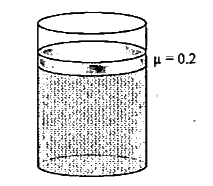A gas cylinder has walls that can bear a maximum pressure of 1.0×106Pa. It contains a gas at 8.0×105Pa and 300K. The cylinder is steadily heated. Neglecting any change in the volume calculate the temperature at which the cylinder will break.
Given
Pmax=1.0×106Pa,
P0=8.0×105Pa,
T0=300K
Volumeisconstant(Given)<br>SoGaslaw,<br> (P_1 V_1)/(T_1)= (P_2 V_2)/(T_2) (:. V_1=V_2)<br> (P_1)/(T_1) =(P_2)/(T_2)<br> or T_2 = (P_max xx T_0)/P_0<br> =(1.0 xx 10^6 xx 300)/(8.0 xx 10^5)<br> = 375K
Topper's Solved these Questions
- KINETIC THEORY OF GASESBOOK - HC VERMACHAPTER - KINETIC THEORY OF GASESEXERCISE - Objective 2
7 Videos
- INTRODUCTION TO PHYSICSBOOK - HC VERMACHAPTER - INTRODUCTION TO PHYSICSEXERCISE - Exercises
19 Videos
- LAWS OF THERMODYNAMICSBOOK - HC VERMACHAPTER - LAWS OF THERMODYNAMICSEXERCISE - Short Answer
15 Videos
Similar Questions
A gas cylinder has walls that can bear a maximum pressure of 1.0×106Pa .It contains a gas at 8.0×105Pa and 300K .The cylinder is steadily heated.Neglecting any change in the volume.If the temperature at which the cylinder will breaks is 75nK find n .?
View SolutionAn LPG cylinder contains gas at a pressure of 300 kPa at 27∘C. The cylinder can withstand the pressure of 1.2×106Pa. The room in which the cylinder is kept catches fire. The minimum temperature at which the bursting of cylinder will take place is __________ ∘C. (Nearest integer)
View Solution
Knowledge Check
A glass container encloses gas at a pressure 4×105 Pa and 300 K temperature. The container walls can bear a maximum pressure of 8×105 Pa. If the temperature of container is gradually increased find temperature at which container will break.
A600KB150KC1200KD375KA cylinder contains accetylene gas at 27∘C and 4.05Mpa. The pressure in the cylinder after half the mass of gas is used up and temperature has fallen to 12∘C will be:
A4.05MPaB2.025MPaC3.84MPaD1.92MPaA gas at constant pressure of 4.5×105Pa to a gas it is compressed from 10 m3 to 3.0m3 on givinig a heat of 800 kJ. The change in internal energy is
A5.25×105JB6.75×105JC1.25×105JD3.25×105J
A glass container encloses a gas a pressure of 8×105 pa and 300 K temperature. The container walls can bear a maximum pressure of 106 Pa. If the temperature of container is gradually increased, find the temperature at which the container will break.
View SolutionA vessel of volume 8.0×10−3m3 contains an ideal gas at 300K and 200kPa. Calulate the amount of the gas (in moles) leaked assuming that the tenperature remains constant.
View SolutionFigure-2.47 shows a cylindrical container of radius 5cm and a piston is fitted in it to enclose a length of 20 cm in it.The cylinder contains an ideal gas at a pressure of 1 atmosphere and 300 K temperature.The cylinder is slowly heated and it is found that the piston starts displacing when the gas temperature reaches 600 K. It is given that the friction coefficient between the piston sidesand the container wall is 0.2. Find the normal force acting between piston sides and the container wall per unit length ofits circumference.

View SolutionAn iron cylinder contains helium at a pressure of 250kPa at 300K. The cylinder can withstand a pressure of 1×105Pa. The room in which the cylinder is placed catches fire. Predict whether the cylinder will blow before it melts or not (m.p of cylinder =1800K)
View SolutionOxygen is filled in a closed metal jar of volume 1.0×10−3m3 at a pressure of 1.5×105Pa. and temperature 400K.The jar has a small leak in it. The atmospheric pressure is 1.0×105Pa and the atmospheric temperature is 300K. Find the mass of the gas that leaks out by time the pressure and the temperature inside the jar equlise with the surrounding.
View Solution
